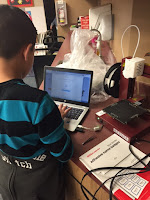I had spoken to a 5th grade teacher about doing it with her math class of about 20 kids. She was super excited. The kids came to the library and I had Michelle explain a little bit about what Ivan had been going through.
We brainstormed a list of positive, encouraging words that we could put on the keychains (I forgot to take a picture of that). Word like: smile, hope, joy, just do it, cheerful, love, shine, etc. The students picked a word and planned out what the word would look like in Braille.
Once the teacher or I checked their Braille, they could begin using Tinkercad to design the keychain.
She also brought some Braille shapes on paper so the students could feel what it was like. She told the students that Ivan was at a school in Austin learning how to adapt to being blind. I then explained about the original keychain that I had made and how we wanted to make more for the other students at the school.
We brainstormed a list of positive, encouraging words that we could put on the keychains (I forgot to take a picture of that). Word like: smile, hope, joy, just do it, cheerful, love, shine, etc. The students picked a word and planned out what the word would look like in Braille.
Once the teacher or I checked their Braille, they could begin using Tinkercad to design the keychain.
When they were finished, the teacher or I checked their work to maker sure the keychain was the right thickness, no shapes were poking through the bottom, the hole went all the way through and that the dots were raised to the right height. The students then wrote the title of their design on a list so I could begin printing them.
After they were printed, I sent them home with Michelle one weekend so Ivan could "proof-read" them for us to maker sure the keychain said what it was supposed to say. She was kind enough to record a video for the students...
The students were super excited about this product and really proud of themselves when they had their finished keychain in hand. They knew they had done something special for the students at the school and felt good about that.

















